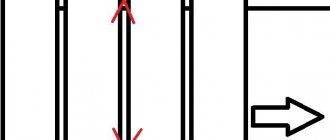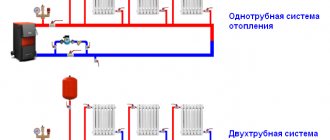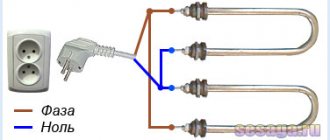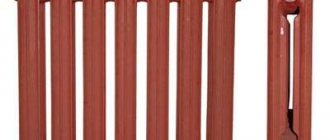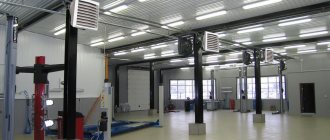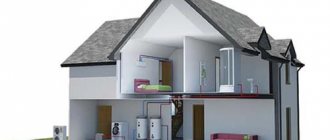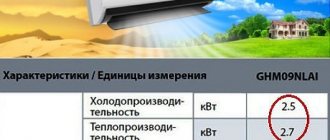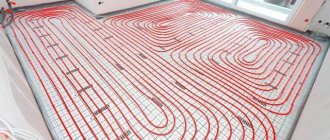Radiator electric heating at home
Installation diagram of the heating element in the radiator
Before installing a heating element into the heating system, you need radiator parameters. The main one is the diameter of the connecting pipe. Currently, manufacturers produce products in two sizes - 1/2 and 3/4 inches. Then a comparative analysis of the heating parameters is carried out before and after installing the heating element.
Connecting the heating element to the existing heating
If it will be used as an additional method of heating water, you need to take into account the change in hydraulic pressure when passing through the radiator. Since the flow diameter of the system this month will be smaller, it is recommended to install a pump of higher power.
When connecting a radiator to the system, installing a heating element for heating the house will not be possible. To do this, you must either change the connection diagram to the top, or install a heating element on the top of the battery, which is not recommended by experts.
They are often installed in old cast iron batteries. Before performing work, you must first check the direction of the thread of the pipe (right or left) and also measure its diameter. Then you should follow this scheme:
- Coolant drain. It is prohibited to install a heating element into a heating radiator if there is water in it;
- Checking the battery level. Even at a slight angle of inclination, the likelihood of air pockets significantly increases;
- Installing the heating element into the pipe. To seal the holes, you must use the gaskets supplied with the heating element or make them yourself;
- Installation of a unit with a thermostat, if included.
An example of installing a heating element in a cast iron radiator
After this, you need to fill the system with water. Using the installed Mayevsky crane, possible air pockets are removed. Before switching on, to ensure safety, a tester is used to check any possible heating coil-battery circuit. If there is one, you need to dismantle the heating element and install it again, improving the sealing.
Radiator electric heating
When organizing heating using heating elements made by yourself, installation of a pipeline is not necessary. A heating element must be installed on each radiator. At the same time, it is possible to install models of different power depending on the thermal conditions in a specific room of the house. The advantages of such a system are as follows:
- Saving on the purchase of materials and reducing the labor intensity of installation work;
- If you use a heating element with a thermostat for heating and a temperature sensor connected to it, the degree of heating of the room will be adjusted automatically;
- Minimum system heating inertia.
But all these positive qualities can be offset by the total cost of service. Therefore, before heating with electric heaters, you need to calculate not only the cost of purchasing materials and components, but also the subsequent costs of electricity. Only after this should a heating system of this type be introduced.
It is recommended to purchase factory radiators with installed heating elements. Their operating efficiency is higher than that of homemade ones, since special oil is used as a coolant. Even when the heating element is turned off, it will give off heat to the room for some time.
Tensions for heating radiators
Heating elements for radiators: characteristics and range, installation
How are electric heating elements used for heating radiators? How much heat output can they provide? Are heating elements suitable for aluminum radiators or for old cast iron radiators? How to ensure safety when installing them? Let's figure it out.
Has the heating been turned off? No problem.
What it is
A tubular electric heater (TEH) is a tungsten heating coil in a ceramic insulator, placed in a sealed metal casing.
Electric heating elements for radiators have several more characteristic features.
- The heating element shell is made of stainless steel. This ensures maximum durability of the product and completely prevents contact of the energized coil with the coolant.
- The nut that ensures installation of the heater in the heating device is brass. Thread - pipe, left or right, size 1 or 1 1/4 inches (DN 25 or DN 32).
Hint: these dimensions ensure compatibility of the heating device with the threads in the sections for the radiator plugs. Cast iron radiators with heating elements are mated with 32 mm threads, aluminum sections have 25 mm threads.
The heating element turned the cast iron battery in the photo into an autonomous heating device.
- Optionally, part of the design may be a thermostat, which ensures automatic maintenance of the specified coolant temperature.
Characteristics and range
Since the rated power of devices is not regulated by any domestic or foreign standards, as an example of the model range we will present the actual product range of the Belgorod company Elektroten. This is quite enough to get acquainted with the design options and current prices.
Kit for 1 1/4 thread (heating element for radiator with thermostat, cord and protective cap)
In addition, of the products that interest us, the company offers:
- Heating element for oil radiator (1 1/4 inch thread).
- Heater for heated towel rails (1/2 inch thread).
Please note: these heating elements can also be installed in a radiator if there is an adapter for the appropriate thread.
Why is this necessary?
Manufacturers position their products as a solution that turns an existing water heating system into an autonomous one with minimal effort and time.
This is necessary in two cases:
- In case of frequent interruptions in the centralized heat supply.
- When organizing completely autonomous heating in the absence of cheaper sources of thermal energy.
The instructions for installing a heating element with your own hands are extremely simple:
- The radiator or section of the heating circuit is reset.
- The lower blind radiator cap is unscrewed. As a rule, it has a left-hand thread, but when connecting a heating device on both sides, the required plug may also be right-handed.
- The last sections are cleared of sludge.
- The thread of the heating element is wound with plumbing flax with paint or any other sealing material.
- Then the heater is screwed into the heating device using an adjustable, open-end or gas wrench. Of course, without excessive effort: brass is a relatively soft metal, and it is not difficult to strip pipe threads on it.
- The radiator is filled with water or other coolant, after which power is supplied to the heating device. The uniform heating of the radiator surface is ensured by convection of the coolant.
- In a central heating system, when the heating element is turned on, the radiator shut-off valves must be closed . In this case, a jumper must be mounted in front of them on the supply line, which will allow the coolant to circulate through the riser when it starts. In the absence of valves, your heating element will heat the batteries throughout the riser; in the absence of a jumper, after an unsuccessful attempt to start the heating, a sad locksmith will come to you and say a lot of offensive words.
- Heating the coolant in a closed volume will turn your radiator into a full-fledged miniature boiler room and... sharply increase the pressure in it . Thermal expansion, you know. Hence the need to install on the supply line after the shut-off valve either a small expansion tank (its volume is taken equal to 10% of the radiator volume) or a safety valve. (See also the article Heating pipes: features.)
When connecting diagonally, the heating element is installed instead of a plug with a right-hand thread (bottom right).
Safety
It is believed that a radiator heating element with a built-in thermostat is an absolutely safe heating device: turning it off when the coolant reaches the set temperature will avoid dangerous overheating or boiling of water.
However, not all potential buyers of the device know that safety and operational efficiency are ensured not only by the design of the device, but also by proper installation.
A small expansion tank will be able to accommodate excess expanded coolant.
Note: the second scenario is undesirable, since when heated the valve will periodically eject streams of hot water.
- The cross-section of the power cord must be at least 1 square millimeter per 8 amperes of current . With a heating element power of 2500 watts and a supply voltage of 220 volts, the current will be 2500/220=11.36A; the minimum cross-section of the wire core, therefore, is equal to 11.36/8 = 1.42 (rounded to the real value - 1.5 mm2).
- The maximum load per outlet should not exceed 3500 watts .
- Grounding is highly recommended .
The grounding contacts in the socket must be connected to the electrical panel housing.
- The power of the heating element without a thermostat should not exceed the rated thermal power of the radiator . For one aluminum section it is taken equal to 200 watts, for cast iron - 160 watts. Heating elements for heating radiators with a thermostat can be installed without power restrictions.
Efficiency mark
Everything is very simple here: 1 kilowatt of electric power of the heating element will give you exactly 1 kilowatt of thermal power, which is completely spent on heating the room. Electric radiators do not have any miraculous properties; positioning mini-boiler houses made of aluminum batteries as economical heating is nothing more than a deception of gullible people.
With a calculated thermal heating power of 100 watts/m2, the maximum power that a heating element with a thermostat for a cast iron radiator can provide—2500 watts—will allow you to heat a room of 25 m2. With an average power consumption of 1500 watts, electricity costs per day will be 1.5 kW/h * 24 h = 36 kW * h, which at current Russian electricity tariffs will cost approximately 36 * 3.8 = 166.8 rubles.
As a constant source of heat, a heating element is an expensive pleasure.
Conclusion
So how should we evaluate the electrical appliances we've studied? If you don’t expect too much from them, it’s purely positive. This is an excellent solution for organizing emergency heating. As long as all safety rules are followed, purchasing them makes sense.
The video in this article will help the reader learn more about heating elements for batteries. Good luck!
Installation of heating elements in heating radiators with a thermostat
In winter, the warmth in the apartment directly depends on the work of utilities. If even in severe cold the radiators in your home are barely warm, it makes sense to take heating of your living spaces into your own hands. To do this, you can install a heating element with a thermostat in the heating radiators. Installing this device will not be difficult, but it is better to take care of everything before the start of the heating season. To install heating elements, you will need to remove the heating radiators, and in winter no one will allow you to do this. Let's figure it out in order.
What are electric heating elements?
TEN is an abbreviation that stands for tubular electric heater. It is essentially a hollow tube made of stainless or carbon steel. Inside there is a wire spiral, which has a high resistance value. For installation, a brass nut is provided, which is screwed into the heating radiator. Heating elements can be installed in any radiators, from old cast iron to modern bimetallic ones.
The best option is a heating element with a thermostat. This device will allow you to control the temperature and protect the heating element from overheating. Oil or water can be used as a coolant. Considering that the heater will be installed in a heating battery, water will play the role of coolant.
Electric heating elements work quite simply. After connecting to the home network, the coil installed inside the tube begins to heat up, transferring energy to the coolant. If the heater is equipped with a thermostat, you can set the required temperature. After the heating batteries heat up to the set temperature, the electrical circuit opens and the heating element turns off. When the liquid in the batteries begins to cool, the heating element will turn on automatically. This scheme will allow you to significantly save on electricity and provide warmth throughout the house.
It is worth noting that a heating element with a thermostat can operate in several modes:
- Turbo. In this mode, the heating element is turned on for a short period of time, but uses maximum power. Turbo mode is used to quickly warm up the room.
- Antifreeze. This function is used mainly in non-residential apartments. The heating element operates at minimum power, preventing the heating system from freezing in the event of an accident.
Installation of heating elements
The heating element is installed according to the following scheme: one of the plugs of the heating battery is unscrewed, and a heating element is installed in its place using a threaded connection. To ensure the tightness of the joint, it is recommended to use a rubber gasket. It is necessary to clarify that it is best to screw in heating elements instead of the bottom plug. There is a logical explanation for this: heated water will rise and cold water will fall. This will ensure the heating element operates most efficiently. This procedure must be repeated in all rooms of the apartment. We remind you that it is better to plan installation before the start of the heating season.
Operating rules
In order for the heating element installed in the heating radiator to serve you as long as possible, you must follow the following rules:
When you decide to install heating elements in your home heating system, choose products that match the diameter of your radiators. In addition, it is necessary to take into account the power of the devices. This will ensure optimal temperature conditions indoors.
When choosing a heating element, you can be guided by the following diagram:
- 20 W/m3. This power is suitable for new buildings that have excellent thermal insulation.
- 30 W/m3 – suitable for apartments with plastic windows, walls and floors equipped with reliable thermal insulation.
- 40-50 W/m3. Heating elements with such power are recommended for use in old houses.
Installing a heating element is the best option to ensure comfort and coziness in residential areas. In fact, this design can be compared to an oil heater, but heating elements provide faster and more uniform heating of all rooms in the apartment. It is worth noting that if the utilities in your city are working at the proper level, it is not advisable to install heating elements. Electricity bills will be quite impressive.
If it turns out that you do not have the tools and necessary skills to perform the actions and processes described above, you can always turn to professionals. We will tell you how much a comprehensive repair or individual work can cost. And also how long it will take and we will offer the best specialists in your city at the lowest prices!
To calculate the cost of work, fill out the form below. It's fast and free! We will call you and discuss all the details in detail!
Do-it-yourself use of heating elements for heating a house: installation in radiators, radiators and boilers
When searching for optimal heating schemes, people often forget about proven methods of maintaining a comfortable temperature in the house. Along with traditional solid fuel boilers, in some cases it is optimal to use heating elements for heating a house with your own hands: batteries, radiators, boilers can include this heating element. However, before you start installing equipment, you need to weigh the pros and cons.
When is it advisable to use heating elements?
First of all, it should be clarified that it is not recommended to make a homemade heater for a heating radiator. This is due to compliance with operational safety regulations. In such designs, it is difficult to prevent a short circuit when electric current penetrates the coolant. Therefore, do-it-yourself heating using heating elements should only be done using factory models.
The heating element is a metal spiral with a high electrical resistance. It is enclosed in a metal shell, which is filled with oil. This ensures a better heat transfer coefficient during operation of the device. When connected to an electrical network, the coil begins to heat up, transferring thermal energy to the surface of the shell. It, in turn, is a heat exchanger between the heating element and water.
It is important to use heating elements for heating in the following cases:
- Creation of heating systems without a main line. To do this, you will need a heating element for a heating radiator with the ability to regulate power;
- Included in electric boilers. If factory models are too expensive, you can make an analogue with your own hands. It is recommended to use a special heating element for the heating boiler as the main heating device. It is characterized by increased power, in most cases it is designed for a network voltage of 380 V;
- For quick heating of the room. Unlike solid fuel for a gas boiler, heating with electric heaters has a minimum heating time for the coolant. If you need to quickly increase the temperature in the room, it is best to use this type of heating.
Comparison of heating costs for different types of energy sources
In addition, electric heating devices are small in size. They are successfully integrated not only into boilers and heating radiators, but also directly into the pipe. Thanks to this, the dimensions of the entire system are reduced, which is important for small houses and apartments. The disadvantage of heating with self-made heaters is the high running costs. In a comparative analysis of various energy carriers, electricity will turn out to be the most expensive.
Is it really effective to use heating elements for heating radiators? Reviews often contain conflicting information. This is mainly due to the lifespan of the heater. The reason for this is improper installation and operation of the device.
You can install a heating element into the heating system yourself. Manufacturers often include installation instructions with the device.
Rules for installation and operation of heating elements
One of the main parameters for each electrical appliance is its rated power. Correct installation of the heater in the heating system is carried out only after calculating this value. To do this you need to use a simple formula:
Where m is the mass of the energy carrier, kg, Tk and Tn are the value of the water temperature after and before heating, T is the required time for raising the temperature to the optimal Tk .
For a 6-section aluminum radiator, m will be equal to 0.45 * 6 = 2.7 kg . Let's assume that Tk=80°С . and Tn=20°C . The heating time should be 10 minutes. In this case, the optimal power that electric heating elements for heating radiators should have will be:
It is taken into account that the coolant is water. With the use of antifreeze, the rated power of the heater for the heating battery must be increased with an adjustment of 1.44 - 1.06 * 1.44 = 1.52 kW .
Then you need to familiarize yourself with the rules for installing electric heating elements for heating your home.
The outer shell must always be in water. If this is not done, the heat from the coil will not be compensated by the low water temperature. As a result, the heating element will quickly fail due to overheating. Therefore, the heater for heating a house is mounted at the lowest point of the radiator. In this case, it will not be in the possible zone of formation of air jams.
Coolant quality
Failed heating element
It is best to use distilled water as it contains minimal % of impurities. When heated, they form a layer of scale on the surface of the protective shell. This not only leads to loss of efficiency of the device, but is also the main cause of corrosion.
Sealing joints
When installing the heater into the heating system, you must first read the instructions from the manufacturer. If it states that the end joints of the electrodes must be additionally sealed, this must be done. Otherwise, if water gets on the surface of the heating coil, the danger for those living in the house increases. After familiarizing yourself with these rules, you can begin installing a heating element.
Not every heating element is suitable for a heating radiator. Only special models with the appropriate mounting diameter should be selected.
Radiator electric heating at home
Installation diagram of the heating element in the radiator
Before installing a heating element into the heating system, you need radiator parameters. The main one is the diameter of the connecting pipe. Currently, manufacturers produce products in two sizes - 1/2 and 3/4 inches. Then a comparative analysis of the heating parameters is carried out before and after installing the heating element.
Connecting the heating element to the existing heating
If it will be used as an additional method of heating water, you need to take into account the change in hydraulic pressure when passing through the radiator. Since the flow diameter of the system this month will be smaller, it is recommended to install a pump of higher power.
When connecting a radiator to the system, installing a heating element for heating the house will not be possible. To do this, you must either change the connection diagram to the top, or install a heating element on the top of the battery, which is not recommended by experts.
They are often installed in old cast iron batteries. Before performing work, you must first check the direction of the thread of the pipe (right or left) and also measure its diameter. Then you should follow this scheme:
- Coolant drain. It is prohibited to install a heating element into a heating radiator if there is water in it;
- Checking the battery level. Even at a slight angle of inclination, the likelihood of air pockets significantly increases;
- Installing the heating element into the pipe. To seal the holes, you must use the gaskets supplied with the heating element or make them yourself;
- Installation of a unit with a thermostat, if included.
An example of installing a heating element in a cast iron radiator
After this, you need to fill the system with water. Using the installed Mayevsky crane, possible air pockets are removed. Before switching on, to ensure safety, a tester is used to check any possible heating coil-battery circuit. If there is one, you need to dismantle the heating element and install it again, improving the sealing.
Radiator electric heating
When organizing heating using heating elements made by yourself, installation of a pipeline is not necessary. A heating element must be installed on each radiator. At the same time, it is possible to install models of different power depending on the thermal conditions in a specific room of the house. The advantages of such a system are as follows:
- Saving on the purchase of materials and reducing the labor intensity of installation work;
- If you use a heating element with a thermostat for heating and a temperature sensor connected to it, the degree of heating of the room will be adjusted automatically;
- Minimum system heating inertia.
But all these positive qualities can be offset by the total cost of service. Therefore, before heating with electric heaters, you need to calculate not only the cost of purchasing materials and components, but also the subsequent costs of electricity. Only after this should a heating system of this type be introduced.
It is recommended to purchase factory radiators with installed heating elements. Their operating efficiency is higher than that of homemade ones, since special oil is used as a coolant. Even when the heating element is turned off, it will give off heat to the room for some time.
DIY electric boiler
Electric boiler design
Is it possible to make a boiler that uses electric heaters to heat a house yourself? First you need to familiarize yourself with the design of factory models.
They consist of a block with an installed heating element, a control and safety system. Unlike traditional boilers, it is small in size and can be installed almost anywhere in the system. For manufacturing you will need the following tools and materials:
- Block of heating elements. It is best to use this type of heaters, as they have maximum power;
- Thermostat and temperature sensor;
- Steel body divided into two zones. In one there will be an electric heating element with a thermostat for heating, and in the second a control and protection unit will be installed.
Since the heating element in the heating system must be constantly in the water, it is recommended to install a liquid level sensor. Liquid circulation occurs through the inlet and outlet pipes. To improve this process, a connection block for the circulation pump is provided. But it should be noted that it is not recommended to make such boilers with a power above 9 kW for a private home. This is due to the maximum load on the power grid and high overhead costs.
An additional heating element installed with a thermostat in the heating can be used as a way to prevent the coolant from freezing. To do this, the device can operate at minimum power.
How to choose heating elements
Heating element for heating with plates
How to choose the right heater for a heating system? Currently, there are many manufacturers who offer similar products. However, both the quality and technical parameters do not always correspond to the required ones. Therefore, before purchasing, you need to pay attention to the following operational characteristics of the heater:
- Rated and maximum power. If a heating element is needed for a heating boiler, its power should be sufficient for the system to operate. The simplest method of calculation is per 10 square meters. at home you need 1 kW of thermal energy;
- Electrical network type. For models with power up to 3 kW, you can use a 220 V home network. If you plan to install a heater for a heating system of higher power, you should install a three-phase 380 V network. This may be due to difficulties in completing the documentation;
- The presence of a thermostat. For a radiator electric heating system, this is the main selection factor. If you purchase a heater without the ability to adjust the power, it will constantly work at maximum mode. This will dramatically increase electricity costs;
- Price. The average price of a 2 kW model starts from 900 rubles. The cost of more powerful ones can be up to 6,000 rubles. They are often made to order.
The appearance of the heating element can also affect its performance and efficiency. The best option would be to purchase a finned heating element for a heating boiler. It differs from conventional ones in that additional heat exchange plates are located on the protective shell.
Thanks to them, the heating area increases. This design is typical for heating elements in heating radiators of larger diameter. Reviews about them indicate increased heat transfer even at minimum operating mode. But their overall dimensions do not always make it possible to install them in a battery. Therefore, simple tubular type heaters are most often purchased. To increase efficiency, you can buy a block of heating elements with a thermostat. It differs from traditional ones by the presence of several heating elements on one base.
Prevention of breakdowns of heating elements
Needle heating element without the ability to adjust power
Even after you have managed to professionally install heating elements for heating systems, you must follow the operating rules. First, the ability of the electrical network to withstand maximum loads is checked. To do this, you need to sum up all the power of electrical appliances in the house and add a factor of 1.2 to the resulting figure for the power reserve. The cross-section of the electrical wiring must withstand the rated power without overheating or short circuiting.
The operation of the heating elements in the device consists in the gradual destruction of the heating spiral. Therefore, heaters intended for radiators must have a maximum service life of at least 10 years, which is confirmed by the manufacturer. In addition, you must follow these rules:
- Do not add tap water to pipes or heating radiators. This can lead to scale formation on the surface of the heating element. Use only distilled water;
- Installation of an RCD (residual current device) is required. You can connect one or more heating elements to it. When an emergency occurs, this device will cut off the power supply;
- Frequently turning the heater on and off when heating a house reduces its service life;
- If static electricity is observed on the surface of the battery, you urgently need to check the tightness of the heating element;
- Installing a heating element into a heating boiler or radiator without grounding is prohibited.
Guided by these simple recommendations, you can create not only an effective, but also a safe heating system for a private house or apartment using electric heating devices.
You cannot install a heater in a heating system without first checking the grounding. To do this, it is best to use the services of an electrical laboratory.
Broken heating element in the boiler or boiler
Replacing a heating element in a heating boiler
Despite their reliability, failure of electric heating heating elements is quite common. If this is a factory model, you can do independent repairs only if you have confidence in your own abilities. It is best to contact a specialized company, since in addition to the heating element, other important parts of the system can be damaged during unqualified repairs.
If you decide to restore the boiler’s functionality yourself, you first need to familiarize yourself with its design. To do this, you can use the data from the passport or look at the data on the manufacturer’s website. Before dismantling the heating element, the device must be secured. Then the coolant is drained. You can check the performance of the heater using the indicator. The passport must indicate the resistance value when closing the circuit. If the indicators do not coincide with the original ones, a new heating element is installed. The best option is to install a similar device from the same manufacturer.
Before installing a heating element into the heating system, you need to make good thermal insulation in your apartment or house. This will reduce ongoing electricity costs, which in turn will increase the life of the heating element.
To check the performance of the heating element, it is recommended to familiarize yourself with the video material.
- Choosing steam heating batteries Equipping with steam heating is an integral part not only in the construction of new buildings, but also in the reconstruction...
- Heating scheme for a two-story house Now let's look at an example of a heating scheme for a two-story house. The diagram shows that for heating the house...
- Vertical heating radiators Buy vertical heating radiators TO VIEW A PHOTO OF THE PRODUCT, SELECT A CATEGORY AND CLICK ON THE PRODUCT! All…
- Heating system for a one-story house The design of a heating system is one of the main points that should be taken into account when constructing any residential building.…
How to choose heating elements
Heating element for heating with plates
How to choose the right heater for a heating system? Currently, there are many manufacturers who offer similar products. However, both quality and technical parameters do not always meet the required
Therefore, before purchasing, you need to pay attention to the following operational characteristics of the heater:
- Rated and maximum power. If a heating element is needed for a heating boiler, its power should be sufficient for the system to operate. The simplest method of calculation is per 10 square meters. at home you need 1 kW of thermal energy;
- Electrical network type. For models with power up to 3 kW, you can use a 220 V home network. If you plan to install a heater for a heating system of higher power, you should install a three-phase 380 V network. This may be due to difficulties in completing the documentation;
- The presence of a thermostat. For a radiator electric heating system, this is the main selection factor. If you purchase a heater without the ability to adjust the power, it will constantly work at maximum mode. This will dramatically increase electricity costs;
- Price. The average price of a 2 kW model starts from 900 rubles. The cost of more powerful ones can be up to 6,000 rubles. They are often made to order.
The appearance of the heating element can also affect its performance and efficiency. The best option would be to purchase a finned heating element for a heating boiler. It differs from conventional ones in that additional heat exchange plates are located on the protective shell.
Thanks to them, the heating area increases. This design is typical for heating elements in heating radiators of larger diameter. Reviews about them indicate increased heat transfer even at minimum operating mode. But their overall dimensions do not always make it possible to install them in a battery. Therefore, simple tubular type heaters are most often purchased. To increase efficiency, you can buy a block of heating elements with a thermostat. It differs from traditional ones by the presence of several heating elements on one base.
Which heating element for a radiator should I choose?
Since there is no great variety in the design and technical features of radiator heating elements, problems in choosing usually do not arise. When purchasing, you should pay attention to the following:
Power - if there is no information about thermal standards for a specific area, you can select a device based on average indicators for central Russia, adjusting them in accordance with the weather conditions of the region. Thus, a heating element with a power of 1 kW is capable of heating the air in a room with an area of 10 m2, provided that there is an autonomous heating system. From this calculation the choice should be made.
Material - there are no particular differences in materials between radiator heating elements from different manufacturers. Their designs are also identical. The difference may be in diameter, that is, in the size of the plug plug. In addition, there are single and double heating elements.
Size - since a heating battery can consist of a certain number of sections, the length of the heating element must correspond to the length of the battery. Experts recommend purchasing a heating structure whose rod is 6-10 cm shorter than the length of the battery. If the heating element is shorter than the required length, it will not be able to provide complete and uniform heating of the coolant.
Availability of additional equipment - if you plan to install an autonomous heating system, then it is better to install models with a thermostat. This will allow you to regulate the temperature in the rooms and reduce electricity costs.
Price is the main thing, do not purchase a heating element for a radiator, putting its cost at the forefront. First of all, you need to be guided by the technical characteristics specified in the product passport. And always remember, cheap doesn’t mean good!
Calculations of the required power of the heating element
When you plan to install an autonomous heating system in a permanent home, it is especially important to correctly calculate the required power of the device. How to do it? The technical documentation for radiators indicates the exact heat transfer values, say, for one cast iron section it will be 140 W. These values must be multiplied by the number of sections. Thus, the required power of the heating element will be obtained.
Calculation of device power
In order not to overpay for electricity and prevent emergency situations, it is necessary to calculate the required power before installing heating elements in the heating system. And it won’t be possible to do this “by eye”. Calculations are made based on the fact that for heating 10 sq.m. the premises require 1 kW of thermal energy. The formula for calculating the power of the heating device is as follows:
where Pm is the design power, m is the mass of the coolant, T1 is the initial temperature of the coolant before heating, T2 is the temperature of the coolant after heating and t is the time required to heat the system to the optimal temperature T2.
Let's consider calculating power using the example of an aluminum radiator in 6 sections. The coolant volume of such a radiator is about 3 liters (precisely indicated in the model data sheet). Let's say we need to heat the radiator by connecting the heating element to the heating battery, in 10 minutes from 20 degrees to 80. We substitute the values into the formula:
Рм=0.0066*3(80-20)/10 = 1.118. that is, the power of the heating element should be about 1-1.2 kW.
The heating element is installed in the lower section of the heating radiators
However, this is only valid if water is used as the coolant. If you need to make calculations for oil or antifreeze. then a correction factor is applied, which is about 1.5. Simply put, the power of heating elements for heating oil heaters should be increased by about one and a half times. Otherwise, the estimated time to reach the optimal temperature will increase.
Criteria for selecting the required materials
Since a homemade device is assembled from units that have already been used, first of all it is necessary to assess the condition of the pipes
Particular attention will need to be paid to their walls. Their thickness should be several millimeters
If corrosion occurs, it is undesirable to use such pipes or be sure to eliminate all defects before use. All rust will need to be thoroughly removed from the metal with a brush, and then covered with an anti-corrosion compound so that the problem does not arise in the future during operation.
For production, pipes with a diameter of approximately 12 cm are usually used. Sheet metal of the appropriate size is used to plug the ends.
To make bypass channels and fittings, you will need to use pipes of a smaller diameter, which can eventually be connected to the heating system. The threads on the fittings are pre-cut, for this reason the appropriate equipment is required - a “drill” (for creating external threads) and a tap (for cutting internal threads).
A DIY oil radiator can be made portable. In this case, small pipes will be used, and oil will be used as the coolant. Heating elements are used instead of heating elements. The choice of this component depends on the area of the room that needs to be heated. Home craftsmen often install an additional thermostat on such a device, which periodically turns the heating element on and off.
For good fastening to the wall, you will also need strong hooks that can support the weight of the resulting unit. To create a more aesthetic appearance, they can be purchased in the store. But if you don’t want to spend additional money, then strong reinforcement bars that need to be fixed in the wall are also suitable. It is advisable to first paint the hooks in the same color that was used to paint the heating device - this way the fittings will become invisible.
Finned tubular type electric heaters
Finned heaters also belong to the tubular type of elements, but they also have ribs that are located in planes perpendicular to the axis of the heater tube. Such ribs are made from metal tape, and they are attached to the tube using washers and clamping nuts. The device itself is made from stainless steel or structural steel.
This type of heating elements are used in heating devices that heat air or gas. They are often found in devices such as thermal curtains or convectors (read: “Electric heating convectors: how to choose - little tricks”). They are used to heat rooms using thermal air mass.
Pros and cons of using heating elements for heating a home
The main disadvantage of this heating method, as in the case of other electrical appliances, is the cost of operating costs. Electricity is still the most expensive source of heat (unless, of course, you have the opportunity to use free solar or wind energy and are connected to the main power grid). Another disadvantage is the impossibility of repair if the spiral fails. However, there are some positive aspects that in some cases may become a priority.
- Environmental friendliness of the heating system. When using electric heating devices, there is no need to stock up and store any fuel, and there are no harmful combustion products that enter the environment;
- Possibility of autonomous installation of a heating system in the absence of access to other thermal resources (for example, gas);
- Small dimensions and a large selection of models in terms of power and functionality;
- Possibility of automating the heating process: installation of heating elements with a thermostat;
- Low purchase and installation costs. There are models whose cost does not exceed 1000 rubles. And you can install heating elements in heating radiators yourself.
And finally, some tips for installing tubular electric heaters yourself. How to properly install a heating element into a heating system? First of all, you need to choose the right model by measuring the diameters of the radiators where the heating element is supposed to be installed and making power calculations. Then carefully read the instructions for the device, which should indicate whether additional sealing is required or not. This is one of the most important points, since contact of the conductor with the heat-conducting liquid will cause your radiators to be energized, and this is dangerous for residents. If the manufacturer indicates the need for additional sealing, then it must be done. In addition, it is unacceptable to use electrical heating devices without grounding.
Location of heating elements in a cast iron heating radiator
Installing heating elements in cast iron heating radiators has a number of features. They are related to the diameter of the pipe and the direction of the thread. In general, the procedure for installing heating heating elements into an existing system is as follows: disconnect the heating system from the heat source, drain the water, install the heating element, fill in the coolant, check the functionality of the system. When using heating elements with thermostats in the heating radiator system, it is also necessary to check their functionality after installation. It is also advisable to install water sensors and check the angles of the radiators. Since air locks can significantly affect the operation of the entire system and damage the heating element.
Heating elements in the heating system
Different types of heating elements
Electric heating devices are often used to heat rooms. One of the varieties of such heating heating elements is tubular electric heaters. What is this widespread device? A heating element is a device for medium-temperature heating of a coolant. Structurally, it is a thin-walled metal tube with a spiral placed inside, which is made of a high-resistance material - nichrome. The ends of the spiral come out in the form of a contact rod, are sealed and are used for connection to the electrical network.
The tube itself is made of steel, carbon or stainless steel. After placing the spiral inside and centering it, the tube is filled with a special coolant - periclase and sealed. Being under high pressure, periclase fixes the spiral along the axis and after that the heating element is bent and given the required shape, depending on the model.
Regardless of how exactly the heating elements will be used - in a solid fuel heating boiler or in an infrared heater - there are certain rules for installing and operating heaters of this type. At the same time, electric heating elements can be used for a variety of purposes: to heat the garage. home heating, for installation in heating boilers or radiators. Let's take a closer look at how to use heating elements for heating.
Tubular electric heater design
Operating principle of heating elements
The heating element works according to the following principle. When connected to the network, the internal spiral is heated and energy is transferred to the thermal conductor and the outer shell. The heat is then transferred to the surrounding fluid, air or solid material.
When heating a heating element immersed in oil or water, convection currents are created around the tube, which mix the coolant and contribute to its uniform heating.
Electric boilers are known for their reliability and maintainability. They do not have many complex parts, so they are easy to operate and maintain.
In liquid-free heating devices, the heating temperature is usually limited so as not to damage surrounding parts or cause a fire.
To speed up heat transfer, they often use a fan, which circulates air both inside the device and in the room surrounding it.
Correct choice of heating element model
When going to purchase a heating element, the buyer needs to know a number of technical characteristics:
- required power of the device;
- length, diameter and shape of the tube;
- length of the insulating cap;
- overall length;
- connection type;
- method of fastening.
To calculate the power of a heating element intended for heating water of a certain volume, use the formula:
P – power of the heated element, measured in kW;
m is the mass of the heated coolant circulating in the device, in kilograms;
tH – initial temperature of water or liquid, in °C;
tK – final temperature of water or liquid, in °C;
T – heating time of water or liquid.
Heating element in a heating radiator - video review:
Using TENs
Recently, more and more people are thinking about the possibility of autonomous heating of their home. Every year the cost of traditional heating increases, so quite often with the help of an autonomous system there is a chance to save money.
Also, sometimes there is simply no possibility of connecting to a central heating system - this is especially true for holiday villages. The only option to heat the house in this case is to install a heating boiler. Solid fuel and gas boilers continue to be the most popular, but their use is also not always possible - access to the main gas pipeline is not always available.
The best way out of such situations is to install electric heating equipment, since electrical networks are available almost everywhere. The main element of any such heating device is TEN. The efficiency of the heating system largely depends on its type. Typically, household heating equipment uses tubular heating elements, as well as elements with a thermostat. The latter make it possible to regulate the operation of the heating system.
Electric heating systems are very convenient to use: they do not emit harmful substances, since they do not form combustion products, do not require installation in a separate room, are safe to use, and are easy to install and adjust. But still, when installing electric heating equipment, you should first check whether the electrical network can withstand the high load. You also need to prepare in advance for the fact that you will have to pay a lot of money for electricity.
Advantages of heating elements
Heating elements (heating elements) have many positive characteristics:
- economy and efficiency - when converting electricity into heat, there is practically no energy loss;
- simple installation - you can even install a heating element for a heating battery yourself and for this you do not need to obtain a special permit from various authorities. Each device is accompanied by detailed instructions from the manufacturer, explaining the connection procedure and operating rules;
- durability - it is achieved through chrome and nickel plating;
- compactness;
- safety;
- an electric heating element with a thermostat for capillary-type heating allows you to regulate the temperature with a high degree of accuracy;
- save energy consumption by allowing the device to operate in pulses;
- affordable price;
- availability of additional functions.
In addition to its positive qualities, a device such as a heating element for heating batteries has several disadvantages:
- high cost of electric heating of residential premises due to electricity prices;
- Not in all settlements throughout the country the electrical power from the substation allows the use of these devices.
What are electric heaters?
Nowadays, tubular electric heaters for heating are popular, they consist of one or several nichrome spirals in a metal shell. Periclast is placed between the spiral and the shell - this material has excellent insulating qualities.
Modern devices have heating elements that have good strength and at the same time can change their size and shape when exposed to high temperatures. At the same time, TENs do not change their technical characteristics. These electric heating elements are used in the production of not only heating equipment for domestic purposes, but also various industrial devices. Heating elements in industrial devices must have high power. Any tubular element, regardless of its type, has a long service life. Today there are several types of heating elements produced by manufacturers of electric heating equipment. First of all, they differ in the manufacturing method, but also have other features. Manufacturers take into account the needs and interests of consumers: some heating devices are produced in large quantities, while others are produced in small quantities. Heating equipment produced in small quantities is usually used in heating systems that have certain features. Accordingly, electric heating elements in such devices are more expensive.
Heater made of battery and heating element
When it comes to deciding how to heat a room: electricity or solid/liquid fuel, consumers are confused by both options because of their high cost. Therefore, many are interested in the question of how to make a heater from a cast iron battery so that it is cheap and does not require special care.
Craftsmen have long been using the advantages provided by installing a heating element. Its main merit is that, with proper connection, it can easily heat small rooms, for example, a greenhouse, garage, workshop or chicken coop, without additional heat sources.
A cast iron battery with a heating element is, in fact, an effective way to autonomously heat a small room or use it as an additional heat source in an apartment in a city heating network.
A heating element is a metal cylinder with a spiral installed inside. The walls of the tube do not come into contact with the spiral due to insulation with a special filler. Installed in a heating device, such a homemade heater made of a cast iron battery has the following advantages:
- This is a reliable design, completely safe for human life.
- This device has high efficiency.
- They are simple and durable to use.
- Heating elements are almost invisible, as they are installed directly into the heating system.
- Since they are equipped with a thermostat, they help save energy resources.
- The amount of electricity it consumes is significantly lower than that of conventional electric heaters, boilers or underfloor heating systems.
- To make such a heater from a cast iron battery with your own hands, you do not need any permits. The heating element is simply mounted into the heating network pipe.
Even a person far from electrical work can install and connect the heating element. As a rule, they are sold complete with parts for installation and protection, control devices and elements for connecting to the electrical network. The heating element is simply screwed into the radiator socket and plugged into the outlet.
It should be remembered that the heating element must be installed in a horizontal position. You can turn on the device for heating the room when there is coolant in the system.
To control safety, the heating elements are equipped with double overheating protection. Control sensors are located both inside the device and outside.
Modern heating elements for connecting to cast iron radiators are equipped with two operating modes, which allows them to be used as the main source of heating, and then they are turned on at full power, or as an emergency or periodic one. In the latter case, it is beneficial to use such technology, for example, in dachas where people do not live permanently, but care must be taken to ensure that pipes and radiators do not freeze.
To make efficient heating from cast iron radiators with your own hands, you need to choose a heating element of suitable power. To do this, a calculation is made taking into account the required heating of the coolant and its quantity in the battery.


